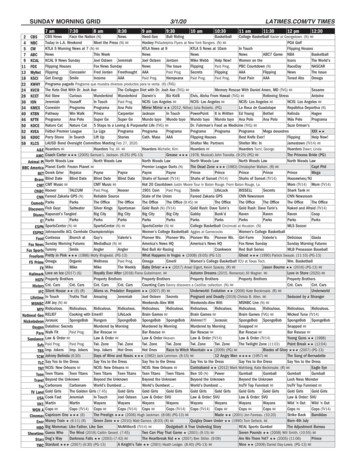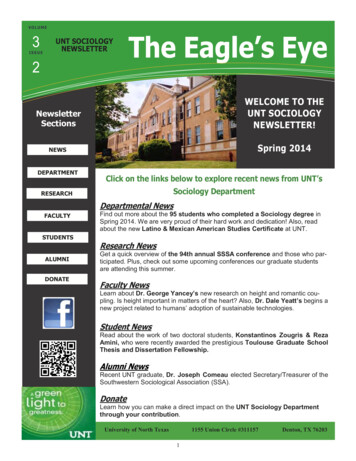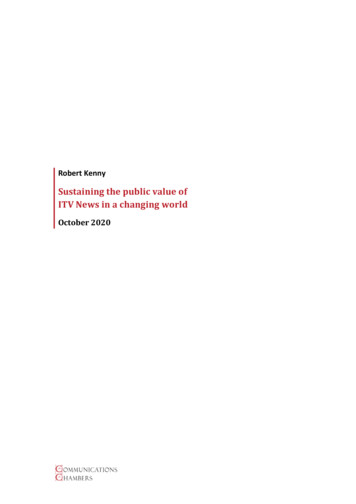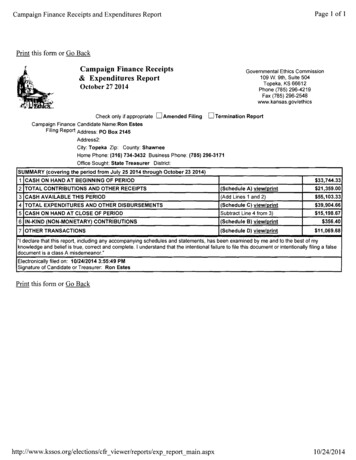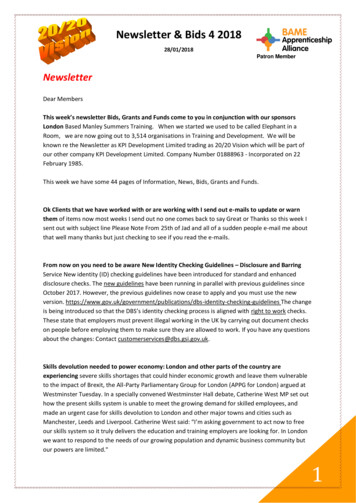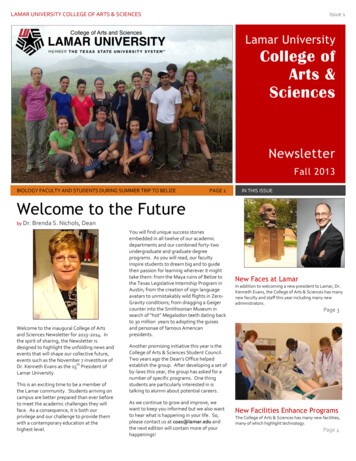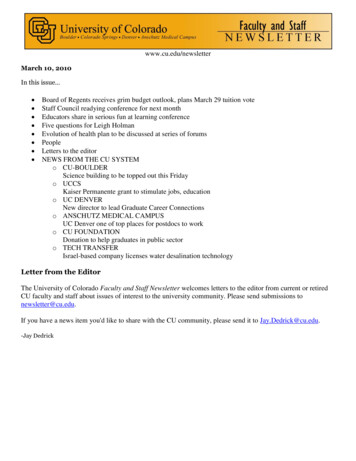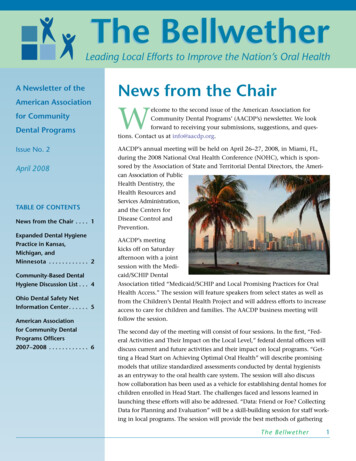
Transcription
The BellwetherLeading Local Efforts to Improve the Nation’s Oral HealthA Newsletter of theAmerican Associationfor CommunityDental ProgramsIssue No. 2April 2008Table of ContentsNews from the Chair . . . . . 1Expanded Dental HygienePractice in Kansas,Michigan, andMinnesota . . . . . . . . . . . . . 2Community-Based DentalHygiene Discussion List. . . . 4Ohio Dental Safety NetInformation Center. . . . . . . 5American Associationfor Community DentalPrograms Officers2007–2008 . . . . . . . . . . . . . 6News from the ChairWelcome to the second issue of the American Association forCommunity Dental Programs’ (AACDP’s) newsletter. We lookforward to receiving your submissions, suggestions, and ques tions. Contact us at info@aacdp.org.AACDP’s annual meeting will be held on April 26–27, 2008, in Miami, FL,during the 2008 National Oral Health Conference (NOHC), which is spon sored by the Association of State and Territorial Dental Directors, the Ameri can Association of PublicHealth Dentistry, theHealth Resources andServices Administration,and the Centers forDisease Control andPrevention.AACDP’s meetingkicks off on Saturdayafternoon with a jointsession with the Medi caid/SCHIP DentalAssociation titled “Medicaid/SCHIP and Local Promising Practices for OralHealth Access.” The session will feature speakers from select states as well asfrom the Children’s Dental Health Project and will address efforts to increaseaccess to care for children and families. The AACDP business meeting willfollow the session.The second day of the meeting will consist of four sessions. In the first, “Fed eral Activities and Their Impact on the Local Level,” federal dental officers willdiscuss current and future activities and their impact on local programs. “Get ting a Head Start on Achieving Optimal Oral Health” will describe promisingmodels that utilize standardized assessments conducted by dental hygienistsas an entryway to the oral health care system. The session will also discusshow collaboration has been used as a vehicle for establishing dental homes forchildren enrolled in Head Start. The challenges faced and lessons learned inlaunching these efforts will also be addressed. “Data: Friend or Foe? CollectingData for Planning and Evaluation” will be a skill-building session for staff work ing in local programs. The session will provide the best methods of gatheringT h e B ellweth e r1
data for evaluating local programs. The meeting willconclude with the session “State Practice Act Work force Issues and How They Impact Access,” which willlook at changing practice acts, including results fromseveral states.More information on AACDP’s annual meeting andon NOHC is available at http://www.aacdp.com/conference and at http://www.nationaloralhealthconference.com. nExpanded DentalHygiene Practice inKansas, Michigan,and MinnesotaOne approach to addressing dental work forceshortages is to create an expanded dentalhygiene practice that allows dental hygienists toprovide services to populations with low incomesand who are underserved. Services are provided incommunity settings, and without a dentist’s directsupervision. According to the American DentalHygienists’ Association, 22 states are identified asdirect-access states, meaning that dental hygienistscan initiate treatment based on their assessment ofpatients’ needs and can maintain aprovider-patient relationship with out a dentist’s authorization ordirect supervision. Following arehighlights of activities from threestates with such provisions:Kansas offers an Extended CarePermit (ECP) for dental hygieneservices. A law passed in 2003 allowsdental hygienists with ECPs to workin Head Start programs, child caresettings, schools, long-term carefacilities, and centers for peoplewith developmental disabilities.2T he Bel l we the rIn the first year, about 20 dental hygienists appliedfor ECPs, although only three or four began provid ing services in the community. In September 2004,Oral Health Kansas received a grant from the UnitedMethodist Health Ministry Fund to hire a part-timeconsultant to encourage hygienists to apply forECPs as a way to augment the dwindling dentalwork force in Kansas. As of March 1, 2008, 80 dentalhygienists had received ECPs. Although there is nocharge for the permit, the hygienist must apply andmust be sponsored by a dentist.Three dental hygienists have become “trailblazers,”each developing an ECP community-based serviceusing different approaches for different target popu lations. Ginny Clark, R.D.H., developed a dentalhygiene service program for adults with develop mental disabilities in partnership with a local devel opmental disabilities agency. Maggie Smet, R.D.H.,established a program for nursing-home residents inthree counties in partnership with an administratorof a long-term care facility and a community dentist.And Kathy Hunt, R.D.H., established school-basedprograms in large and small school districts.According to Marcia Manter, community develop ment specialist with Oral Health Kansas, the ECPmodel has been most successful in safety net clinicsthat have embraced it as a way to expand their ser vices. In addition, local health departments are pilot ing the ECP model to prevent oral disease, mostly in
children and pregnant women. Currently, no dentalhygienists with ECPs are working independently, butKansas law is open to an entrepreneurial model, sothis may change.Kansas developed an Extended Care Permit Toolkit thatprovides information for oral health professionalsworking in community agencies who are interestedin developing new ways of delivering preventive ser vices to individuals in the communities where theylive. The toolkit includes laws governing ECPs, therole of the sponsoring dentist, financing informa tion, equipment needs, and sample written agree ments. The toolkit can be accessed at .For more information the ECP, contact Marcia Manterat mmanter@aol.com.In Michigan, Public Act 161 (PA 161) was passedinto law in 2005 to facilitate increased access to oralhealth care services for underserved populations inthe state. The law allows dental hygienists approvedby the Michigan Department of Community Healthto provide preventive oral health care without a den tist’s prior authorization in a variety of public healthsettings, including federally qualified health centers(FQHCs). Under PA 161, dental hygienists maintaina supervisory relationship with a dentist and referpatients who need additional oral health care. Theprogram enables dental hygienists to bring preven tive oral health care directly to those who cannotaccess care in traditional office settings.Over 100 dental hygienists work in various prac tice settings in Michigan where clients can receivedental hygiene services without a dentist’s examina tion. These hygienists work in collaboration with adentist through a remote type of supervision con tract in venues including prisons, FQHCs, schools,local public health departments, and six stand-aloneprograms for underserved populations. One exampleof such a stand-alone program is the PA 161 programat Meadow Brook Medical Care Facility, where PeggySloma, R.D.H., with 26 years’ experience in clinicalpractice and dental sales, began providing servicesin September 2006. Ms. Sloma works in partnershipwith the long-term care facility to provide care tothe 250 residents. As a result of PA 161, MeadowBrook residents have access to oral health assess ments and preventive care.The Michigan Dental Hygienists’ Association(MDHA) published a handbook, The MeadowbrookModel, to provide information to others who areinterested in how the program started. MDHA alsoproduced a flyer, PA161—Making Oral Health CareAccessible in Michigan, with PA 161 program informa tion and highlights.For more information about the program, or toobtain copies of MDHA materials, contact JackieBalcom at balcomja@co.muskegon.mi.us.Minnesota’s collaborative practice statute allows adental hygienist licensed under this provision to per form dental hygiene services without the patient beingexamined by a dentist. The dental hygienist must,however, meet certain requirements, including currentcertification in advanced or basic cardiac life supportand completion of courses in infection control andmedical emergencies. The hygienist must also enterinto a written collaborative agreement with a dentistwho authorizes the services that the hygienist provides.The agreement outlines the parameters of care and theservices that may be provided. In addition, the dentalhygienist must have been engaged in the active practiceof clinical dental hygiene for at least 2,400 hours in thepast 18 months or for at least 3,000 hours during hisor her career as a whole, including a minimum of 200hours in 2 of the past 3 years.T h e B ellweth e r3
In December 2006, the Administration for Childrenand Families’ Office of Head Start authorized dentalhygienists who have a collaborative agreement witha dentist licensed in Minnesota, and who have com pleted the Association of State and Territorial DentalDirectors’ Basic Screening Survey calibration exercise,to provide oral health assessment, triage, and referralfor children enrolled in Head Start in the state. Thisprocess is recognized as meeting the Head Start oralexamination program performance standard. The in tended outcome is the creation of linkages betweendental hygienists who provide services in Head Startprograms and dentists in private practice or commu nity clinic settings who provide follow-up services, ifnecessary.Visit http://www.normandale.edu/dental for ad ditional information about the agreement. Thesite features the text of the statute; a collaborativeagreement template; dental hygienists’ descriptionsof their experiences; and information about mobileportable equipment, professional liability insurance,Medicaid, and grant funding.For more discussion on expanded dental hygienepractice, attend AACDP’s session “State Practice ActWorkforce Issues and How They Impact Access,”which will offer a look at the local impact of chang ing practice acts in several states. nMarcia Manter and Jackie Balcom contributed content tothis article.Community-BasedDental HygieneDiscussion ListThe Community-Based Dental Hygiene (CBDH)discussion list is designed to facilitate electroniccommunication among dental hygienists who pro vide services in community settings. Members fromacross the country can submit inquiries or com ments to the group and reply to others’ messages.4T he Bel l we the rCBDH was established to foster learning and partner ships among the growing number of dental hygien ists permitted by their state practice acts to provideservices beyond the dental office. Via the discussionlist, subscribers exchange information and solutionsto problems related to community-based services insites such as schools, health departments, and longterm care facilities.Membership is open to dental hygienists providingservices in community-based settings. To subscribe,submit contact information (name, title, organi zation, type of community organizations served,address, city, state, zip code, phone number, faxnumber, and e-mail address) to Marcia Manter, listmoderator, at mmanter@aol.com.The CBDH discussion list was developed by com munity-based dental hygienists and is hosted by theNational Maternal and Child Oral Health ResourceCenter. n
Ohio Dental SafetyNet InformationCenterThe Ohio Dental Safety Net Information Center(ODSNIC) is a one-stop online resource centerfor safety net dental clinic personnel in Ohio. Theinformation center is a Web site that focuses onconcepts and tools and provides distance-learningopportunities.Features of the Web site include a comprehensivedefinition of safety net dental clinics, links to keyoral health grantmaking organizations in Ohio,sources of county- and state-level data, a searchableclinic-locator database, electronic newsletters anddiscussion lists, job listings, and loan-repaymentinformation. Three new distance-learning modulesare available via ODSNIC; they focus on clinicalcare (coming soon), clinic operations, and financialmanagement.Clinical Operations for Safety Net Dental Clinics in Ohiois a series of modules designed to help clinic staffimprove efficiency and quality of care, meet patients’needs, and set up an infrastructure that is conduciveto these ula/operations/index.htmlstakeholders, in the form of an advisory committee,also contributed to the development of the Web site.Committee members included staff from the OhioDepartment of Health, safety net dental clinics, foun dations, and the Ohio Association of CommunityHealth Centers, as well as individuals with expertisein education and curriculum development.Visit ODSNIC at http://www.ohiodentalclinics.com. nPermission is given to forward The Bellwether:Leading Local Efforts to Improve the Nation’s OralHealth, in its entirety, to others. For all other uses,requests for permission to duplicate and useall or part of the information contained in thispublication should be sent to the address below.The Bellwether: Leading Local Efforts to Improve theNation’s Oral HealthNational Maternal and Child Oral HealthResource CenterGeorgetown UniversityBox 571272Washington, DC 20057-1272Phone: (202) 784-9771Fax: (202) 784-9777E-mail: info@mchoralhealth.orgWeb site: http://www.mchoralhealth.orgFinancial Management for Safety Net Dental Clinics inOhio is a series of modules designed to help clinicstaff learn about all aspects of financing a clinic andensure that the clinic remains financially sustainableover the long nance/index.htmlThe Anthem Foundation of Ohio, a supporting orga nization of the Greater Cincinnati Foundation, pro vided funding to the National Maternal and ChildOral Health Resource Center to develop ODSNIC incollaboration with the Ohio Department of Health,Bureau of Oral Health Services. A broad group ofT h e B ellweth e r5
American Association for Community Dental Programs Officers 2007–2008ChairLarry Hill, Greater Cincinnati Oral Health Council,Cincinnati, OHE-mail: larryhill@fuse.netChair-ElectKatrina Holt, National Maternal and Child OralHealth Resource Center, Washington, DCE-mail: kholt@georgetown.eduMaureen Oostdik-Hurd, Madison Department ofPublic Health, Madison, WIE-mail: moostdik@cityofmadison.comCarrie Janszen, Northern Kentucky IndependentDistrict Health Department, Edgewood, KYE-mail: carriejanszen@ky.govSecretary/TreasurerSharon Perlman, Oral Health Consultant, Chicago, ILE-mail: sjperlman@sbcglobal.netJackie Campbell Brumley, Greater Cincinnati OralHealth Council, Cincinnati, OHE-mail: oralhealth@fuse.netExecutive Committee MembersMyron Allukian, Oral Health Consultant, Boston, MAE-mail: myalluk@aol.comAmos Deinard, University of Minnesota,Minneapolis, MNE-mail: deina001@umn.eduKathleen Endres, Wisconsin Department of Healthand Family Services, Menasha, WIE-mail: endrekm@dhfs.state.wi.us6Judy Gelinas, St. Luke’s Hospital, Maumee, OHE-mail: gelinaj@slhhn.orgT he Bel l we the rNancy Rublee, Price County Health Department,Phillips, WIE-mail: nancy.rublee@co.price.wi.usScott Wolpin, Choptank Community Health Center,Federalsburg, MDE-mail: swolpin@choptankhealth.org
The dental hygienist must, however, meet certain requirements, including current certification in advanced or basic cardiac life support and completion of courses in infection control and medical emergencies. The hygienist must also enter into a written collaborative agreement with a dentist who authorizes the services that the hygienist provides.



